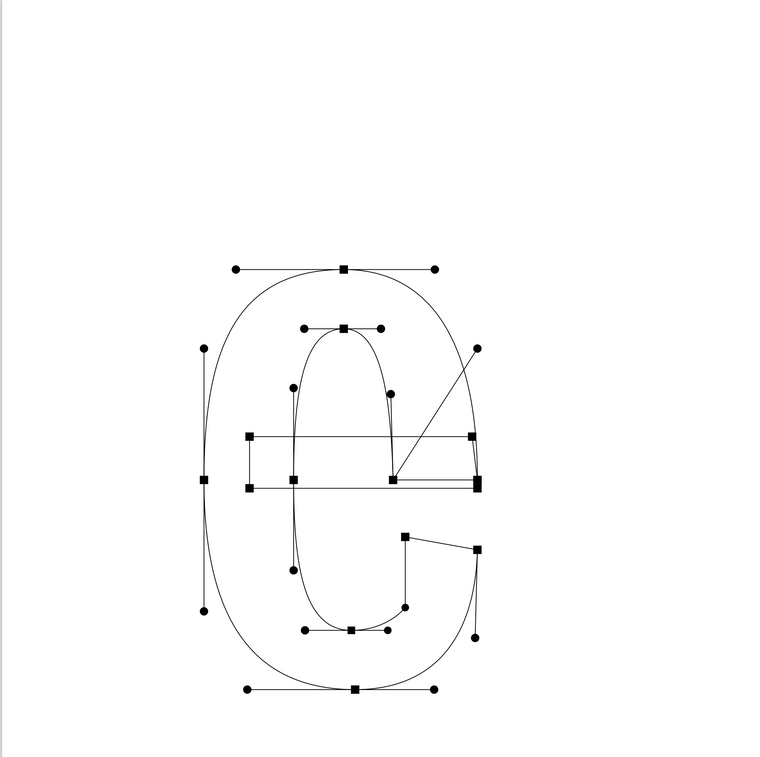How to draw a line connecting all off curve points to on curve points
-
I've been hitting my head against the wall trying to figure out the best way to loop through glyph data to draw the outline and show the points and handles, essentially showing the drawing information that's inside RoboFont.
I'm able to loop through the segments and contours and draw the curve / plot the points but I'm not able to connect all the off curve points to the relevant on curve points.

g = CurrentGlyph() newPage(1000,1000) P = BezierPath() diameter = 10 translate(240,100) # DRAW CONTOURS for contour in g.contours: P.moveTo((contour[0][0].x,contour[0][0].y)) for segment in contour: # IF IT'S A CURVE DRAW A CURVE if len(segment) == 3: x1,y1 = segment[0].x, segment[0].y x2,y2 = segment[1].x, segment[1].y x3,y3 = segment[2].x, segment[2].y P.curveTo((x1,y1),(x2,y2),(x3,y3)) # SHOW THE OFF CURVE POINTS oval(x1-diameter/2,y1-diameter/2,diameter,diameter) oval(x2-diameter/2,y2-diameter/2,diameter,diameter) # SHOW THE ON CURVE POINTS rect(x3-diameter/2,y3-diameter/2,diameter,diameter) #DRAW A LINE stroke(0) line((x2,y2),(x3,y3)) # IF IT'S A LINE DRAW A LINE if len(segment) == 1: x,y = segment[0].x, segment[0].y P.lineTo((x,y)) #SHOW POINTS rect(x-diameter/2,y-diameter/2,diameter,diameter) P.closePath() fill(None) stroke(0) drawPath(P)I'm sure there are more elegant ways to get at the point data and I have a feeling it might be a job for a Pen? My intention is to make little animations and generate graphics for identity presentations and the like so it's not critical for me to load use this data to drew new glyphs back into RoboFont.
Any insight would be greatly appreciated!
-
@micahmicah I have no experience with RoboFont, but I assume this wil work. The trick is to remember the last point and use that as the first point.
g = BezierPath() g.oval(0,0,500,500) newPage(1000,1000) P = BezierPath() diameter = 10 translate(240,100) # DRAW CONTOURS for contour in g.contours: # DEFINE STARTING POINT x3,y3 = (contour[0][0][0],contour[0][0][1]) P.moveTo((x3,y3)) for segment in contour: # LAST POINT BECOMES THE FIRST POINT x0,y0 = x3,y3 # IF IT'S A CURVE DRAW A CURVE if len(segment) == 3: x1,y1 = segment[0][0], segment[0][1] x2,y2 = segment[1][0], segment[1][1] x3,y3 = segment[2][0], segment[2][1] P.curveTo((x1,y1),(x2,y2),(x3,y3)) # SHOW THE OFF CURVE POINTS oval(x1-diameter/2,y1-diameter/2,diameter,diameter) oval(x2-diameter/2,y2-diameter/2,diameter,diameter) # SHOW THE ON CURVE POINTS rect(x3-diameter/2,y3-diameter/2,diameter,diameter) # DRAW A LINE stroke(0) line((x2,y2),(x3,y3)) line((x0,y0),(x1,y1)) # IF IT'S A LINE DRAW A LINE if len(segment) == 1: x,y = segment[0][0], segment[0][1] P.lineTo((x,y)) #SHOW POINTS rect(x-diameter/2,y-diameter/2,diameter,diameter) P.closePath() fill(None) stroke(0) drawPath(P)
-
Thanks @monomonnik ! I had a feeling I needed to target the previous point and was unsure how to do it.
There are a few issues I ran into when porting your example over that I think are specific to how the point data is stored in the .UFO
I ran into this error
Traceback (most recent call last): File "<untitled>", line 14, in <module> TypeError: 'RPoint' object is not subscriptableWhen I print
segment[0]I get the following output:<RPoint offcurve (311, 717) at 140588776786576>I adjusted your example to the following which targeted the x and y for each segment rather than the third array
x1,y1 = segment[0].x, segment[0].y x2,y2 = segment[1].x, segment[1].y x3,y3 = segment[2].x, segment[2].yWhich allowed the code to run but it looks like there's something about one of the last off curve points in the loop not drawing to the proper on curve point and closing the path improperly on some of the drawings.

I ran into the same issue with different glyphs as well just to make sure there wasn't something wrong with my drawing.


The above results were from running the script as such:
g = CurrentGlyph() newPage(1000,1000) P = BezierPath() diameter = 10 translate(240,100) # DRAW CONTOURS for contour in g.contours: # DEFINE STARTING POINT x3,y3 = (contour[0][0].x,contour[0][0].y) P.moveTo((x3,y3)) for segment in contour: x0,y0 = x3,y3 # IF IT'S A CURVE DRAW A CURVE if len(segment) == 3: x1,y1 = segment[0].x, segment[0].y x2,y2 = segment[1].x, segment[1].y x3,y3 = segment[2].x, segment[2].y P.curveTo((x1,y1),(x2,y2),(x3,y3)) # SHOW THE OFF CURVE POINTS oval(x1-diameter/2,y1-diameter/2,diameter,diameter) oval(x2-diameter/2,y2-diameter/2,diameter,diameter) # SHOW THE ON CURVE POINTS rect(x3-diameter/2,y3-diameter/2,diameter,diameter) #DRAW A LINE stroke(0) line((x2,y2),(x3,y3)) line((x0,y0),(x1,y1)) # IF IT'S A LINE DRAW A LINE if len(segment) == 1: x,y = segment[0].x, segment[0].y P.lineTo((x,y)) #SHOW POINTS rect(x-diameter/2,y-diameter/2,diameter,diameter) P.closePath() fill(None) stroke(0) drawPath(P)Thanks again for your help and insight
-
@micahmicah Maybe, if the last segment is a line, the last point is not updated?
Maybe change:
# IF IT'S A LINE DRAW A LINE if len(segment) == 1: x,y = segment[0].x, segment[0].y P.lineTo((x,y)) #SHOW POINTS rect(x-diameter/2,y-diameter/2,diameter,diameter)to:
# IF IT'S A LINE DRAW A LINE if len(segment) == 1: x3,y3 = segment[0].x, segment[0].y P.lineTo((x3,y3)) #SHOW POINTS rect(x3-diameter/2,y3-diameter/2,diameter,diameter)(I’m coding blind, I have not tested this)
-
Thanks so much! That worked. It does seem like for some drawings it helps if I set a different starting point for the contour but this is perfect for my needs.
Thanks again, I really appreciate it.